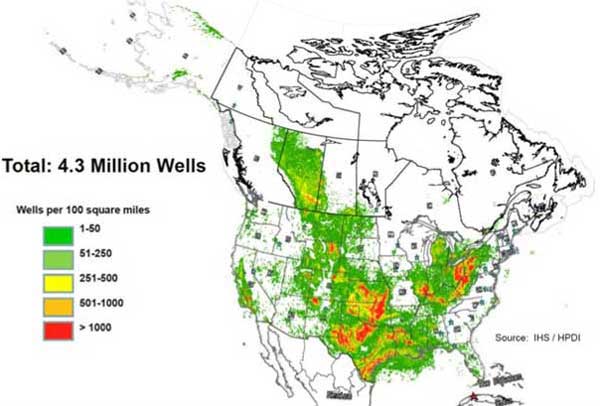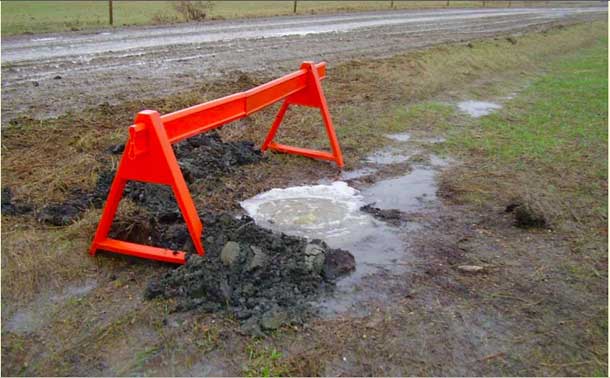A Princeton University study has found that leaks from abandoned oil and gas wellbores pose not only a risk to groundwater, but represent a growing threat to the climate.
Between 200,000 and 970,000 abandoned wells in the state of Pennsylvania likely account for four to seven per cent of estimated man-made methane emissions in that jurisdiction, a source previously not accounted for, the study says.
Pennsylvania, much like Alberta in Canada, is the oldest oil and gas producer in the United States and the scene of intense environmental controversy due to the impact of hydraulic fracturing on its well-punctured landscape.
For the study, the first of its kind, PhD student and civil engineer Mary Kang measured methane emissions from 19 abandoned wells in northern Pennsylvania.
Abandoned oil and gas wells can serve as pathways for methane, radon, brine and other hydrocarbons that can migrate into shallow groundwater aquifers, people's homes or into the atmosphere.
Methane is a powerful greenhouse gas with a global warming potential that is 86 times greater than carbon dioxide over a 20-year time frame.
As a consequence, leaks from the shale gas and conventional gas infrastructure could make the industry dirtier than coal production.
Scientists in the field have consistently found that models used by the oil and gas industry and regulators significantly underestimate methane leaks from valves, pumps, pipelines, gas plants and producing wells. Abandoned wells have now been added to the list.
Cornell University ecologist and methane expert Robert Howarth said the new study is important because it illustrates that emissions from oil and gas activities are much higher than government and industry estimates.
The problem of leaking abandoned wells "has not been well studied in the past and is not at all considered by the U.S. Environmental Protection Agency in their greenhouse gas emission estimates, nor by other academic studies such as mine. It is yet one more example of how little we really know about methane emissions from the oil and gas industry, and yet one more reason to believe that the EPA has been severely underestimating the total emissions," he said.
There is nothing terribly unique about Pennsylvania, added Howarth, "so I would expect this to be a problem affecting most if not all gas and oil fields."
The problem of wellbore leakage, however, is widespread and global, and involves millions of oil and gas wells. Well failures in Norway's offshore fields, for example, averaged 24 per cent in one analysis while well failures for newly-fractured shale wells in Pennsylvania average 6.4 per cent.
Saskatchewan shows failure rates as high as 20 per cent. Extensive leaks from heavy oil wells (up to 45 per cent) have resulted in documented groundwater contamination in the Lloydminster area on the border of Alberta and Saskatchewan.
Escaping gas
Kang's findings reinforce the findings of a University of Waterloo study that called the nation's 500,000 leaky wellbores a threat to public safety and the environment due to "potential groundwater quality deterioration, contributions to greenhouse gas emissions, and explosion risks if methane gas accumulates in inadequately ventilated areas."
The Waterloo study also called for regulators and industry to immediately monitor and measure emissions from tens of thousands of abandoned wells in Western Canada. It also noted that documented gas emissions from wellbores represent only a fraction of what is escaping underground into groundwater or other formations.
In Pennsylvania, Kang found that abandoned wells leak on average about 96 cubic metres a year, but there may be anywhere from 280,000 to 970,000 such wells in the state alone.
About 16 per cent of all wells didn't leak small amounts, but appear to be "super-emitters" or methane gushers. The highest-polluting well seeped 3.2 cubic metres of gas a day, or 1,168 cubic metres of gas a year. That's nearly $300 worth of natural gas annually.
In comparison, according to Enbridge a typical Canadian resident uses 3,064 cubic metres of gas a year to heat their home and water.
About 10 per cent of all wells leak in British Columbia, but no monitoring is done on the rate of leakage from the province's 10,000 inactive or abandoned wells. Some producing hydraulically-fractured shale gas wells have become super-emitters and leak as much as 3,000 cubic metres a year.
Other startling findings
Kang also made several other startling findings.
Methane leaks from plugged wells, which were properly sealed with cement at the time of their abandonment, were just as high as rates from unplugged wells.
Wells connected to sandstone formations leaked more often than wells constructed in other formations.
She also found ethane, propane and n-butane mixed with the methane -- all indicators that the gas came from zones targeted by industry as opposed to swamps or natural sources.
The pulse of the methane flowing into the atmosphere changed over time, too. During the winter the leaks grew smaller, while during the summer more and more methane flowed from the wells.
The dramatic findings of the Princeton study again illustrate that cement seals in active and abandoned wells crack, shrink and fracture over time, allowing methane to leak and find the path of least resistance, such as natural fractures.
Stray gas can travel distances as great as 14 kilometres away and pop up in rivers and homes.
To get regulators and industry to address the problem, Kang suggested in her PhD thesis that "gases, including methane and other hydrocarbons, emitted from abandoned oil and gas wells" should be considered "as an alternative energy resource."
More abandoned than reclaimed
The contamination of drinking water with methane has been documented in Pennsylvania, Colorado and Texas, or wherever hydraulic fracturing and intense drilling has taken place. But in many cases, regulators have brushed aside scientific evidence and concluded the methane is naturally occurring.
The Alberta Energy Regulator maintains a database of leaks for 316,439 wells reported by industry dating back to 1910. But it is not in the public domain, and the regulator has no policy for testing gas leaks from wells once they have been abandoned.
Currently, the liability for the abandonment and reclamation of inactive wells, pipelines and facilities totals $32 billion in Alberta. Yet the regulator holds $279 million in security bonds to clean up the mess.
Oil and gas companies are abandoning wells at a much faster rate than they are reclaiming them, a process that includes a cement evaluation and the placement of a venting cap on top of the well.

Theresa Watson, a former Alberta regulator, noted in a 2013 presentation that an increasing number of horizontal multi-stage hydraulic fractured wells were directly contacting pre-existing wellbores with the "potential to impact assets (other industry property) and groundwater."
To date, there have been more than 20 cases of industry performing high-pressured frack jobs that connected with nearby wells, resulting in eruptions of toxic fluids to the surface.
Some so-called "frack hits" travelled as far as 2,400 metres through natural or man-made fractures and faults before coming to surface. More than 30 such events have happened in British Columbia. All pose risks to groundwater.
"The skeletons are coming out of the closet," said Watson in her presentation.
Kang concluded that governments need to do a better job reporting and monitoring abandoned wells, because they appear to be a significant and unexpected source of unaccounted methane emissions.
"Additional measurements are required to characterize and determine the distribution of methane fluxes from abandoned oil and gas wells in Pennsylvania and other regions," she wrote.
A major 2014 study by U.K. researcher Richard Davies in Marine and Petroleum Geology reached the same conclusion and called for systematic long-term monitoring for both active and abandoned wells. ![]()
Read more: Energy, Environment
















Tyee Commenting Guidelines
Comments that violate guidelines risk being deleted, and violations may result in a temporary or permanent user ban. Maintain the spirit of good conversation to stay in the discussion.
*Please note The Tyee is not a forum for spreading misinformation about COVID-19, denying its existence or minimizing its risk to public health.
Do:
Do not: